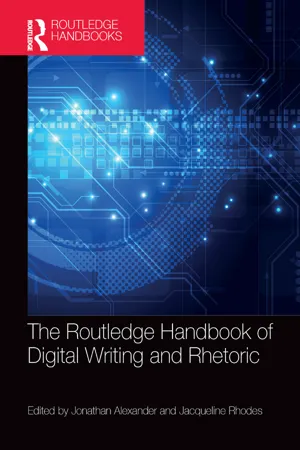
The Routledge Handbook of Digital Writing and Rhetoric
- 468 pages
- English
- ePUB (mobile friendly)
- Available on iOS & Android
The Routledge Handbook of Digital Writing and Rhetoric
About this book
This handbook brings together scholars from around the globe who here contribute to our understanding of how digital rhetoric is changing the landscape of writing. Increasingly, all of us must navigate networks of information, compose not just with computers but an array of
mobile devices, increase our technological literacy, and understand the changing dynamics of authoring, writing, reading, and publishing in a world of rich and complex texts. Given such changes, and given the diverse ways in which younger generations of college students are writing, communicating, and designing texts in multimediated, electronic environments, we need to consider how the very act of writing itself is undergoing potentially fundamental changes. These changes are being addressed increasingly by the emerging field of digital rhetoric, a field that
attempts to understand the rhetorical possibilities and affordances of writing, broadly defined, in a wide array of digital environments. Of interest to both researchers and students, this volume provides insights about the fields of rhetoric, writing, composition, digital media, literature, and multimodal studies.
Frequently asked questions
- Essential is ideal for learners and professionals who enjoy exploring a wide range of subjects. Access the Essential Library with 800,000+ trusted titles and best-sellers across business, personal growth, and the humanities. Includes unlimited reading time and Standard Read Aloud voice.
- Complete: Perfect for advanced learners and researchers needing full, unrestricted access. Unlock 1.4M+ books across hundreds of subjects, including academic and specialized titles. The Complete Plan also includes advanced features like Premium Read Aloud and Research Assistant.
Please note we cannot support devices running on iOS 13 and Android 7 or earlier. Learn more about using the app.
Information
PART I
Cultural and Historical Contexts
1
DIGITAL WRITING MATTERS
Whether we call it texting, IMing, jotting a note, writing a letter, posting an email, blogging, making a video, building an electronic presentation, composing a memo, keeping a diary, or just pulling together a report, Americans are writing like never before.Recent research suggests that writing, in its many forms, has become a daily practice for millions of Americans. It may be the quintessential 21st century skill …
Digital Writing in/and the Networked Context
The Networked Context
As society turns to social media as a primary method of communication and creative expression, social media is supplementing and in some cases supplanting letters, journals, serial publications and other sources routinely collected by research libraries … Archiving and preserving outlets such as Twitter will enable future researchers’ access to a fuller picture of today’s cultural norms, dialogue, trends and events to inform scholarship, the legislative process, new works of authorship, education and other purposes. (Allen; Library of Congress)
Techno-pedagogy for the Networked Context
Digital Writing and Collaboration
The Collaborative Context
Techno-pedagogy for the Collaborative Context
Table of contents
- Cover
- Half Title
- Title Page
- Copyright Page
- Table of Contents
- List of Figures
- Notes on Contributors
- Acknowledgments
- Introduction: What Do We Talk about When We Talk about Digital Writing and Rhetoric?
- Part I Cultural and Historical Contexts
- Part II Beyond Writing
- Part III Being Rhetorical and Digital
- Part IV Selves and Subjectivities
- Part V Regulation and Control
- Part VI Multimodality, Transmediation, and Participatory Cultures
- Part VII The Politics and Economics of Digital Writing and Rhetoric
- Index